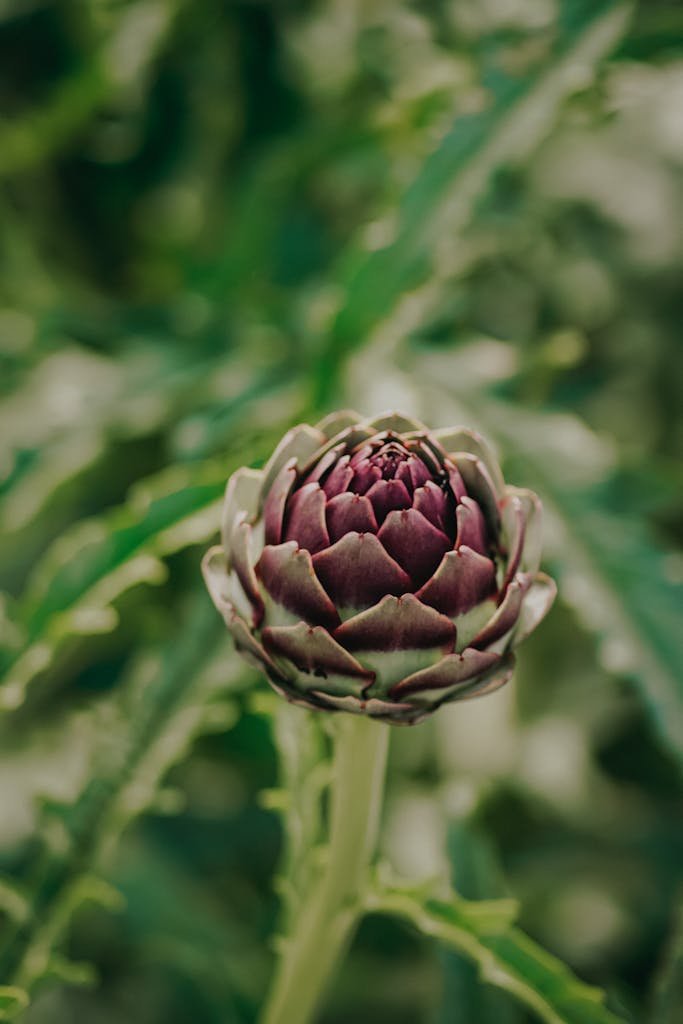
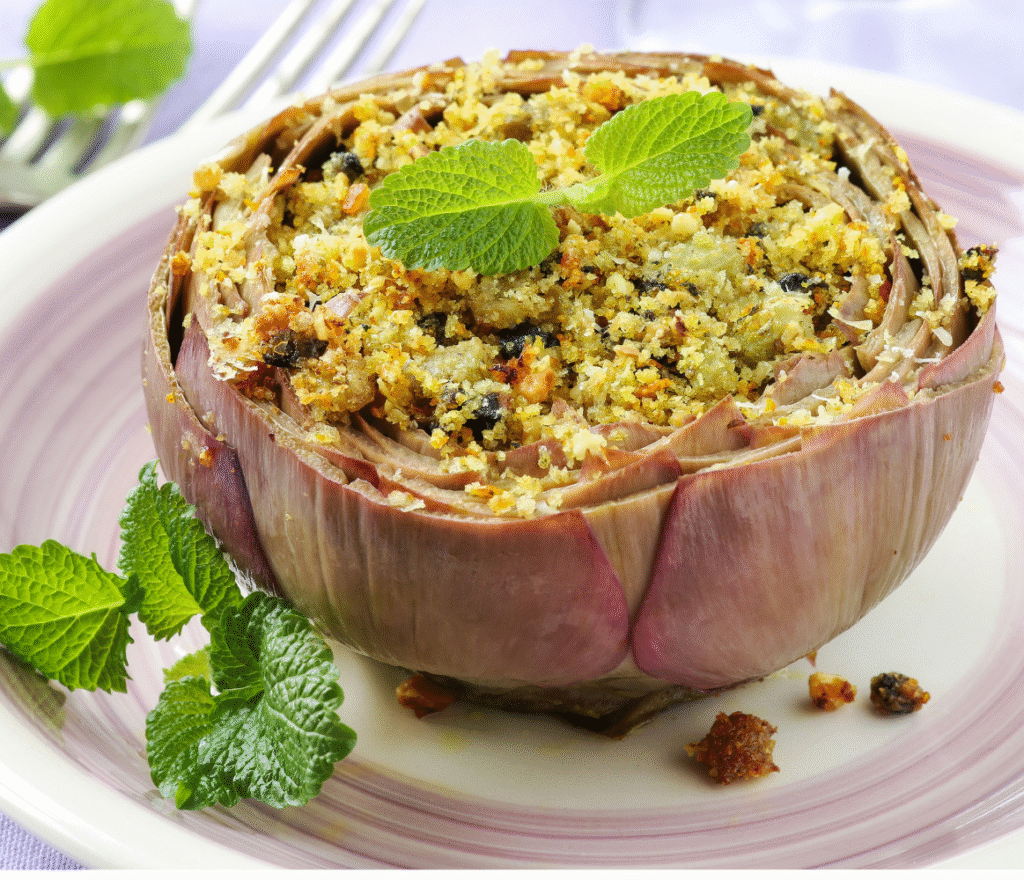
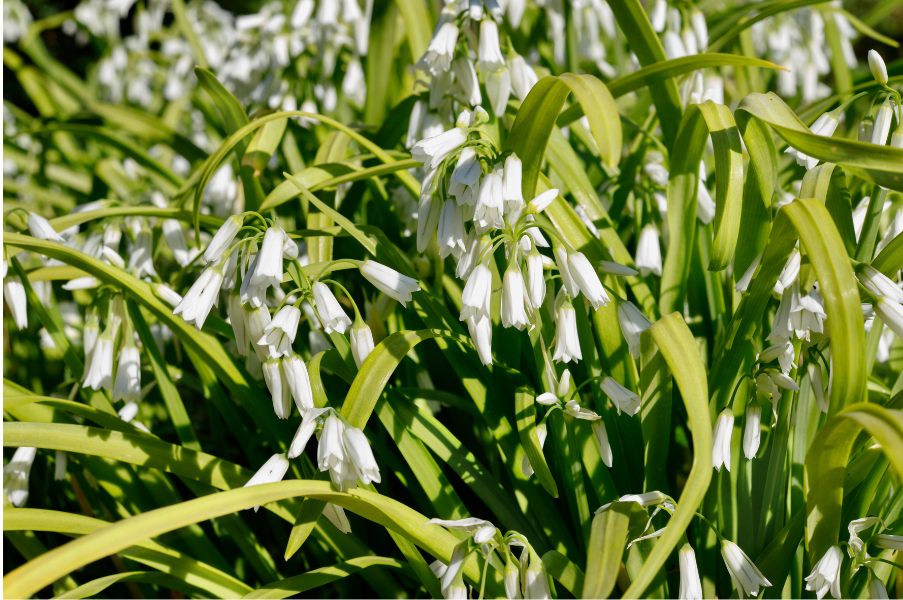
Stuffed globe artichokes with herby quinoa might sound fancy, but they’re one of those feel-good, slow-food dishes that speak of patience, beauty, and good soil.
I started growing globe artichokes because I wanted something perennial for the farm — something that would return each year without much fuss. But mostly, if I’m honest, I planted them because they’re just so stunning. Their big silvery leaves and tall flower stalks look like they belong in a painting. Even when I don’t eat them, I still admire them.
This dish brings together the garden, the wild hedgerows, and the warmth of a shared meal. It’s simple, nourishing, and a little bit magical. The herby quinoa is laced with fresh sorrel and three-cornered leek — two wild herbs that add bursts of bright, lemony and oniony flavour. If you’ve never cooked with them before, you’re in for a lovely surprise.
Best of all, this recipe feels like a celebration of the season. Whether you’re harvesting from your own patch, the roadside, or a friendly neighbour’s field, it’s a way to turn what’s growing into something truly special.
So if you’ve got artichokes (or a reason to go find some), take a slow afternoon to try this. The process is half the joy. A little prep, a gentle steam, a big spoonful of goodness — and dinner is served, with a side of sunshine and stories.
All About Globe Artichokes
What Are Globe Artichokes?
First, globe artichokes are actually flower buds from a big, silvery-green plant. They look a bit like mini pinecones—unique and eye-catching! They grow well in cool places, and once planted, they come back year after year.
Best Growing Conditions in Ireland or Cool Temperate Gardens
For success, plant them in full sun and rich soil. They don’t like waterlogged ground, so good drainage is key. In Ireland, they thrive in spring and early summer. Once they’re established, they’re hardy and don’t need replanting each year — that’s why they’re considered perennials!
When to Harvest and How to Select the Best Ones
You pick artichokes when the leaves are tight and firm. If the buds start to open and show purple, it’s too late—they might taste bitter. Choose medium-sized buds that feel heavy for their size. That way, you’ll get a tender, flavorful artichoke.
Nutritional Benefits: Fibre, Antioxidants, Liver Support
Surprisingly, artichokes are super healthy! They’re rich in fibre, which is good for digestion. They also have antioxidants called polyphenols, which are great for your body. Plus, they contain substances that support your liver—making them a smart choice for healthy eating.
Tips for Prepping and Cooking (Steaming, Trimming, Removing the Choke)
- Trim first: Cut off the stem so it can sit flat, and snip the sharp tips of the outer leaves.
- Prevent browning: Rub the cut parts with lemon juice—just like in the video.
- Steam gently: Use a steamer basket and let them cook for about 30–40 minutes until a leaf pulls out easily
- Remove the choke: Once they’re soft, scoop out the fuzzy center with a small spoon. Then they’re ready to eat!
All About Garlic Scapes
Garlic scapes are one of those garden surprises that feel like a little gift from nature. Just when the hardneck garlic is settling in for summer, it sends up a curly green shoot that looks like it belongs in a fairy tale. That’s your garlic scape! We harvest them in late spring or early summer, just before the flower forms. Picking them early helps the garlic bulb below grow bigger and better.
So, what do they taste like? Imagine garlic—but gentler. Garlic scapes have a fresh, green flavor with just enough bite to wake up your taste buds. Raw, they’re crunchy like green beans. Cooked, they soften and mellow out, perfect in stir-fries, soups, scrambled eggs, or blended into a bright green pesto.
One of the best things about garlic scapes is how sustainable they are. You’re not just growing garlic for the bulbs—you’re getting a second crop from the same plant. No waste, just flavour and joy.
And they’re not just tasty! Garlic scapes are full of good things like allicin (that’s the compound in garlic that’s great for your heart), plus a dash of vitamin C and antioxidants to keep your body happy.
Want to store them? Pop them in the fridge and they’ll keep for up to three weeks. Or chop them up and freeze for later, or blend into pesto and freeze in little cubes.
🌿 You can read more about how we grow, harvest, and use garlic scapes right here.
All About Three-Cornered Leek
How to Identify (Allium triquetrum): stems, flowers, smell test
First, look at the stem—it’s triangular if you cut it. That’s why it’s called three‑cornered leek! Then, check the flowers. They’re white, bell‑shaped, with a green stripe down each petal. Finally, give a gentle sniff. When you crush a leaf between your fingers, it smells like a soft onion. That’s your green light to identify it confidently.
When and Where to Forage in Ireland
You’ll usually find it between early spring and June. It loves hedgerows, ditches, shaded lanes, or even stream banks. When you’re out walking, peek under low bushes or along old stone walls. Just remember: always ask permission before foraging on private land.
Flavour Profile: Sweet Onion‑Garlic, Gentle, Fresh
This leek tastes like a soft cross between an onion and garlic. It’s gentle—not spicy—and quite fresh. Think of it like onion-flavored spring sunshine. And the flowers? They’re pale and sweet, perfect for tossing on salads or soups.
Nutritional Benefits: Vitamin C, Flavonoids, Prebiotic Fibres
Three‑cornered leek is more than just tasty—it’s healthy too! It gives you vitamin C, keeps your gut happy with prebiotic fibres, and offers flavonoids (those are plant helpers that support your body). It’s like adding a little green boost to your day.
All About Sorrel
How to identify common sorrel (Rumex acetosa)
If you’re walking along a field edge or a shady lane and spot a cluster of long, lance-shaped leaves that look a little like spinach, you might have just found common sorrel. It’s one of those greens that practically waves at you when you know what to look for. The leaves have a slight arrowhead shape and a smooth, shiny surface. To be sure, give it a gentle nibble—if it gives you a fresh lemony tang, you’ve got the right plant.
Flavour profile: lemony, tangy, refreshing
Sorrel is nature’s zingy little surprise. It brings a sharp, lemony flavour that can really wake up a dish. It’s especially lovely in spring and summer recipes when you want something light and bright. Add it to salads, whizz it into soups, or stir it through warm grains like quinoa—just be sure to use it fresh, as cooking can dull its colour (though the taste holds strong!).
Nutritional benefits: vitamin C, potassium, and more
Not only does sorrel taste delightful, but it’s also packed with vitamin C and potassium. It contains oxalic acid too—that’s the compound that gives it that tangy punch. While it’s totally safe in small amounts for most people, anyone with kidney concerns should go easy, just to be cautious.
Where it grows wild and how to harvest ethically
You’ll often find wild sorrel in grassy meadows, along ditches, and even peeking out from hedgerows. It loves damp, fertile ground. When harvesting, take just a few leaves from each plant, leaving the roots intact. That way, it can keep growing and feed pollinators and other foragers, too.
Garden sorrel vs. wild sorrel
You might also come across garden sorrel in seed catalogues or your neighbours’ plots. It’s a cultivated cousin that tends to be larger and slightly less sharp in flavour, but still delicious. If you love wild sorrel, growing your own is a lovely way to have a steady supply close to the kitchen.
Foraging safety tip: triple-check lemony leaves
One last note—always triple-check the ID of any lemony-tasting green you find in the wild. A few toxic plants can look similar to the untrained eye. Use a good foraging guide (or app), and when in doubt, don’t nibble. Safety first, always.
Foraging in Ireland: A Beginner’s Guide
What Is Foraging and Why It’s Amazing
Foraging is the old-school art of gathering wild plants, herbs, and sometimes fruit from nature. It’s a free way to add nutrition, flavour, and joy to your meals—straight from hedgerow to kitchen. Plus, it connects you with the seasons in a way that feels magical.
Top Tools for Foraging Success
Here are a few essentials I always take with me:
- Folding Foraging Knife – Handy and safe, ideal for clean harvesting.
- Canvas Foraging Bag or Basket – Breathable and sturdy, perfect for delicate greens or flowers.
- Pocket Plant ID Guide (Affiliate Link) – Choose one specific to Irish or UK flora.
- Phone App (like Seek by iNaturalist) – Great for real-time plant ID and confidence.
- Notebook or Foraging Journal – Track what you’ve found, where, and when.
(Affiliate links to each can go here as a bulleted block or styled product showcase.)
Best Books to Learn More
If you’re keen to deepen your foraging knowledge, here are a few trusted books I return to again and again:
- Food For Free by Richard Mabey
- The Forager’s Calendar by John Wright
- The Wild Remedy by Emma Mitchell (beautiful for mindful foraging)
Foraging Responsibly: Wild Doesn’t Mean Free for All
When it comes to foraging, it’s easy to get swept up in the excitement of finding fresh, free food right at your feet. But just because it’s growing wild doesn’t mean we get to take as much as we want. In fact, part of the joy of foraging is knowing how to do it kindly—both to the plants and the land. First things first: always make sure you’re allowed to forage in the spot you’re in. Some areas in Ireland are protected, and it’s important to check local rules or ask permission from landowners when needed.
Next, think about the bigger picture. That patch of wild greens might look like it’s bursting with bounty, but bees, birds, and other foragers (human and not) rely on it too. A good rule is to only take what you’ll use, and leave plenty behind. I like to follow the “one-third rule”—gather one-third, leave two-thirds. That way, the plant can keep growing, and others can enjoy it as well.
It’s also worth remembering that wild places are delicate. Stick to established paths when you can, don’t trample moss or wildflowers, and never dig up roots unless you know it’s safe and allowed. Lastly, always leave the place looking just as lovely as you found it. If you bring a bag, take your rubbish back out with you—and maybe even pick up a bit extra if someone else forgot theirs. Foraging is a gift, and treating nature with care is the best way to say thank you.
How to Cook Perfect Quinoa & What It Is
Quinoa basics: what it is, where it comes from, why it’s so good
Quinoa (pronounced keen-wah) isn’t actually a grain—it’s a tiny seed from the Andes. But you cook it like a grain, and it behaves a lot like couscous or rice. It’s naturally gluten-free, high in protein, and full of goodness like fibre, iron, and magnesium. Even better? It has a gentle, nutty flavour that fits in just about anywhere—from salads to stuffings.
How to rinse and cook fluffy quinoa every time
Here’s the secret to perfect quinoa: rinse it well! Quinoa seeds have a natural coating called saponin that can make them taste bitter. Just pop them in a fine mesh sieve and give them a good rinse under cold water for about 30 seconds. Then, cook with a ratio of 1 part quinoa to 2 parts water. Bring to a boil, reduce to a simmer, cover, and let it cook for 15 minutes. Once all the water is absorbed, turn off the heat and let it steam (covered) for another 5 minutes before fluffing with a fork.
Why it’s great for stuffing dishes
Quinoa is light, fluffy, and doesn’t overpower other ingredients. That makes it ideal for stuffing into globe artichokes, peppers, or even mushrooms. Plus, it’s full of plant-based protein, so you’re adding real substance to your meal without weighing it down.
Optional flavour boosters: lemon zest, broth, herbs
Want to take it up a notch? Swap water for veggie broth, toss in a strip of lemon zest while it simmers, or stir in fresh chopped herbs like parsley or sorrel at the end. These tiny changes bring a bright, fresh twist that pairs beautifully with seasonal veg and foraged finds.
How to store cooked quinoa for meal prep
Cooked quinoa keeps well in the fridge for up to 5 days, sealed in an airtight container. It also freezes beautifully. Make a big batch and portion it out for easy weekday meals—it thaws in a flash and saves so much time.
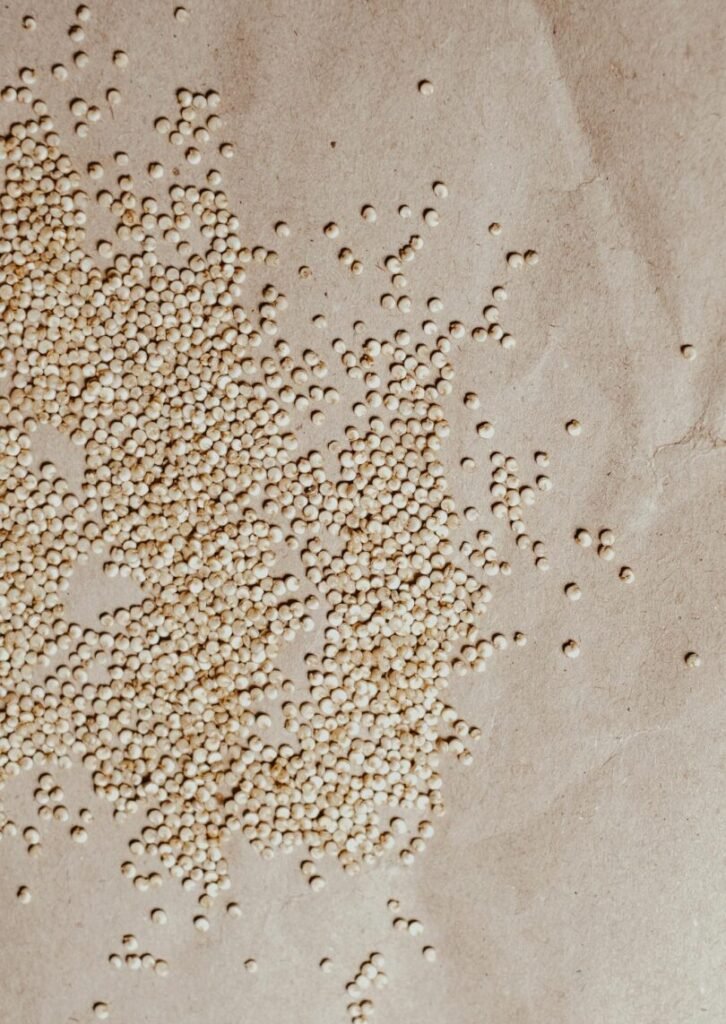
Recipe — Stuffed Globe Artichokes with Herby Quinoa
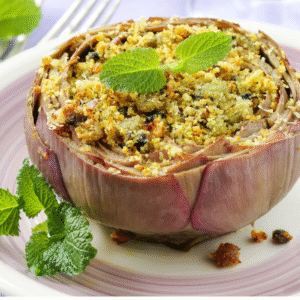
Stuffed Globe Artichokes with Herby Quinoa
Ingredients
For the artichokes:
- 4 medium Artichokes about 300 g each
- 1 lemon for acidulated water
- 1 tbsp Olive oil
- 1/2 tsp Salt
For the Herby Quinoa Stuffing
- 150 g Quinoa
- 300 ml water
- 2 Garlic scapes minced
- 2 tbsp three cornered leek finely chopped
- 20 g wild sorrel finely chopped
- 10 g fresh parsley
- 15 ml Lemon juice about 1/2 Lemon
- 22 ml Olive oil
- Salt and Pepper to taste
Optional toppings:
- 1 tsp Sunflower seeds for crunch
- Grated cheese or vegan cheese
Instructions
Prepare the Artichokes
- Fill a large pot with water and squeeze in the juice of 1 lemon. Add the lemon halves too.
- Trim the artichokes: cut off the stem so they sit flat, snip the spiky tips of the outer leaves, and remove any tough outer leaves.
- Gently open the leaves and scoop out the fuzzy choke with a spoon.
- Place them into the lemon water to prevent browning.
Cook the Artichokes
- Bring a large pot of salted water to a boil and steam the artichokes for 25–30 minutes until tender (a leaf should pull away easily).
- Drain and let cool slightly.
Cook the Quinoa
- Rinse the quinoa under cold water.
- In a pot, toast the quinoa for 2 minutes with a splash of olive oil, then add water and a pinch of salt.
- Bring to a boil, reduce heat, cover, and simmer for 15 minutes.
- Let stand for 5 minutes off heat, then fluff with a fork.
Prepare the Herby Filling
- In a pan, sauté garlic and shallot/wild onion in olive oil until soft (2–3 minutes).
- Add to the quinoa along with chopped sorrel, parsley, lemon zest, lemon juice, olive oil, salt, and pepper.
- Mix well. Sorrel will wilt slightly from residual heat.
Stuff the Artichokes
- Gently open each artichoke and spoon quinoa mixture inside, pressing it between the leaves and into the heart cavity.
- Sprinkle with sunflower seeds and optional cheese or nutritional yeast.
Bake to Finish (Optional but recommended)
- Preheat oven to 180°C (350°F).
- Place stuffed artichokes in a baking dish. Drizzle with olive oil and a splash of water or stock.
- Cover with foil and bake for 10–15 minutes to warm through and crisp the tops.
Serve
- Serve warm with a wedge of lemon and a drizzle of good olive oil. Pairs beautifully with a light salad or steamed greens.
Notes
Notes
- Lemony Herb Substitution: Sorrel (Rumex acetosa) has a bright, lemony taste that pairs beautifully with quinoa. If you can’t find it wild, garden sorrel or even a small amount of lemon balm or wood sorrel (Oxalis spp.) can work.
- Wild Onion Notes: Wild onions like Allium vineale (crow garlic) or Allium triquetrum (three-cornered leek) are excellent spring foraged flavors. Substitute with shallots or scallions if foraging isn’t possible.
- Make It a Meal: Serve with a chilled white wine or elderflower cordial.
- Make Ahead: You can prep the quinoa and steam the artichokes a day ahead. Assemble and bake before serving.
- Allergy-Friendly: Gluten-free, nut-free, and easily made dairy-free/vegan.
Conclusion
And there you have it—beautiful, bold globe artichokes filled to the brim with lemony quinoa and wild greens straight from the hedgerow. It’s the kind of meal that feels like a little celebration of June. With every bite, you’re tasting something fresh, local, and just a bit wild.
What I love most about this recipe is how it brings the garden, the woods, and the kitchen all together on one plate. The artichokes may take a little love to prep, but once you get the hang of it, they’re a joy to work with. The filling is easy, nourishing, and packed with the bright green flavours of the season. And knowing you picked the sorrel and three-cornered leek yourself? That just makes it taste even better.
If you’re like me, and you’re leaning into seasonal, feel-good food that celebrates what’s growing right now, don’t stop here. There’s a whole table full of recipes waiting for you, each one designed to make the most of what June has to offer—without fuss or fancy ingredients. Just honest food and a little green magic.
👉 Head back to the June Recipe Collection for more garden-to-table inspiration.
Whether you’re cooking for yourself or feeding a crowd, I hope this dish brings a little joy and a lot of flavour to your day. Happy foraging, happy cooking—and most of all, happy eating.
